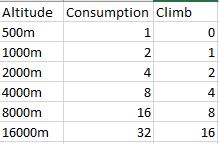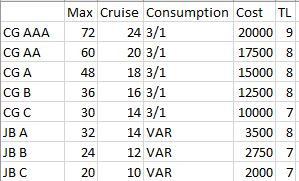Future Imperfect - Personal Locomotion
Personal Locomotion
Items classified as personal locomotion provide movement ability to a character without being a vehicle per se, though they do still count as vehicles for continuous action purposes when using powered flight.
JUMP BELTS/GRAV BELTS: The Jump Belt is worn on the back and is attached to a person with a harness similar to that of a parachute. The Jump Belt operates under certain restrictions which should be noted by all operators:
1. The Jump Belt can ‘nullify’ a maximum of 225 kg 1495 lbs.), A ‘jump’ may be made if the total mass in the field does not exceed 225 kg. If a greater load is placed within the field, the reliability becomes F, and must check for breakdown every minute. On a catastrophic breakdown, the nullgrav generator will burn out. Balrad and Saurian units can ‘nullify’ 275kg.
2. An interruption of the grav-field lines generated by the Jump Belt will result in complete loss of lift. If in the air, the wearer will fall as gravity reasserts itself. Interruption is caused by the ‘interpenetration’ of another Jump Belt or GravSled field (within 2m) or the ‘immediate proximity’ (within 2m) of a large, fixed object such as a building, wall, cliff face, etc. An operator can ‘synchronize’ his Jump Belt with that of another in 30 seconds (5 combat turns) so that both fields will be compatible as long as physical contact is made. This permits several Jump Belt troopers to effect a ‘pick-up’ on a fallen comrade.
3. Because of its low power, the Jump Belt can operate only within a large gravity field, Such as that of a planet, ‘riding the magneto-gravitic lines of force of the planetary body itself. Remember: the 2m proximity rule applies, so ‘flight’ must be at least 2m from the ground. The higher one goes, the greater the power consumption. All Jump Belts have a powercell with 100 ‘charges’ which can be expended at the following rates:
The cost to climb to a given altitude must be met as well as the cost to remain at that altitude for one hour. Each altitude level counts separately. Thus, to climb to 7000m from the ground requires expenditure of power to attain 500m, 1000m, 2000m, 4000m and finally 7000m, for a total of I + 2 + 4 + 8 = 15 power charges. Fractional times spent at altitude may be divided into 15-minute segments. That is, for each 15 minutes or portion thereof which are spent at a given altitude, 1/4 of the power expenditure occurs (minimum of 1 charge in any event). Thus it will cost 1 charge to remain at 500m for 15 minutes. It would also cost 1 charge to remain at 600m because the 1-charge minimum rule applies.
4. Jump Belts are also capable of powered flight at low speeds. Power consumption is 1 charge per hour to maintain a standard speed. Max. speed = 1/4 max jump speed.
The standard technique used to move with a Jump Belt is a series of short jumps which do not take the user very far from the ground (usually 2m to 4m off the ground) and covering a distance of 10m to 25m per jump so that an over-all speed approaching that of a running man is produced. The effort requires some gymnastics, and a fatigue rate equal to about half that of normal running occurs. The user jumps parallel to the ground to avoid hanging in the air. Gravity will not do it for him. This procedure tends to make a series of short jumps look like a tumbler doing somersaults and deciding not to do the roll at the last minute, rather continuing his horizontal jump for a considerable distance then kicking down to land on his feet. This requires training and practice. (see 4.6 Armsman Skills for Jump -Belt training). Untrained personnel almost always make long, rather high jumps, rather than the more difficult short, low lumps (1.4 chance on 1d6). Green troops have a 1 in 6 chance of making such a mistake. Regular and veteran troops will almost never be so clumsy.
Jump Belts never suffer a ‘serious’ breakdown in the air unless it is the result of powercell failure. The controls will give ample warning in time to reach the ground (usually a matter of simply falling to low altitude, then kicking in the field at full power in the last few meters, similar to opening a delayed-action parachute). On the ground, a breakdown means that the unit refuses to lift at all. Minor breakdowns are merely inefficiency in power utilization, with double power consumption; serious breakdowns are total malfunctions.
As a final note, most terrain will not affect .Jump Belts. Rough terrain cuts the allowed movement by -25% because of the added hazards in landing. Woods and swamps cut movement by -50%, and dense woods by -75%. Jump Belt equipped personnel can jump over obstacles such as water, woods, etc., provided the obstacle is not more than 1/2 normal jump belt movement in clear terrain. Vertical jumps can be 1/4 the distance of normal jump belt movement in clear terrain. Any farther requires that the ‘climb’ function be cut in, which requires 6-20 seconds to set. Troops jumping over water and unable to clear it will find that their Jump Belts will not lift them out of water. The Jump Belt cuts in automatically to act like a parachute when a 20m drop has occurred. This function may be overridden to allow a free-fall drop or may be activated after 10m (allowing for react10m time) if a person accidently falls.
All Jump Belt powercells cost CR 75 each and mass 250gm. They can be recharged with 100 charges of power in about 1 minute, at a cost of CR 30. IRSOL powercells are triple-charge units, also massing 250gm but costing CR 175. They can be recharged with 100 charges in 3 minutes at a cost of CR 90. Jump Belts themselves mass 5 kg, and have a breakdown on 1/4. Costs = CR 3500 for type ‘A’, CR 2750 for type ‘B’, and CR 2000 for type ‘C’. See combat movement for speeds.
CONTRA—GRAVITY HARNESS: The CG Harness is a heavy-duty version of the Jump Belt, capable of lifting 500kg total mass. The unit is also called a Flying Belt, for it is fully powered by a small TurboGrav or reaction (rocket) pack. Since the drive provides the motive power, use of Flying Belts is not fatiguing. However, under power, the user must either stay in the air and make himself a good target, or he must attempt to fly ‘nap of earth’ like an aircraft. Nap of earth flying requires extreme concentration and can cause a crash. The units may be employed to make short jumps, as described for Jump Belts. All Jump Belt rules and restrictions apply, except that the Abbot null-grav unit is no longer affected by inter-penetrations and proximity problems because it is effectively damped like a GravSled unit.
@Power consumption is per 15 minutes of powered flight, This expenditure is in addition to basic Jump Belt consumption rates. However, climbs under power are made at 1/2 Jump Belt costs plus Max. Speed CG consumption rates. Flight at altitude can be made at CG rates, which are more economical than Jump Belt rates.
@@Cruising Speed is maximum economical speed with a CG Harness. The decimal factor in brackets is the multiplier which can be used to convert any of the speeds to scale speeds. For example, 72 km/h = .33 of 216 km/h. Speed in 6 minutes covers .33 x 21,600 = 7128m. Six second scale = 14.4 x .33 = 4.75 scale measure units (either inches or cm.)
All CG Harness units come equipped with a standard 200 charge power-pack, which masses, along with reaction fuel, 10 kg. Cost = CR 300. Recharge costs CR 75. Double-duty units can be had with mass 20 kg at CR 550, and recharge CR 150. Note: The reaction fuel is included in the concept of ‘charge’ to simplify bookkeeping and game mechanics.
All CG Harnesses themselves mass 15 kg. Cost = CR 10,000 for CG ‘C’, with each class above that costing an additional CR 2500. CG ‘AA’ may be worn with armour no heavier than class ‘C’ energy armour (light Scout Powered Armour, for instance). CG ‘AAA’ cannot be worn with armour heavier than class ~D’ energy armour: this is topflight spacesuit JetPack gear. Breakdown of all CG Harness is on 1/2.

